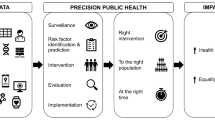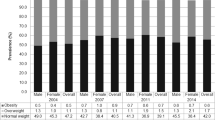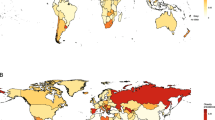Abstract
Purpose of Review
Childhood obesity is increasing substantially in many Pacific island countries and poses an urgent and serious challenge. The Sustainable Development Goals set by the United Nations and the NCD Roadmap created at the request of the Pacific Finance and Economic Ministers identify prevention and control of noncommunicable diseases as core priorities. Among the various risk factors responsible for the development of noncommunicable diseases (NCDs), overweight and obesity are particularly of concern with the potential to negate many of the health benefits that have contributed to increased life expectancy. With the increase in childhood obesity across the region, it has become apparent that surveillance data remains a challenge; however, it is essential to inform the development of effective policies and strategies to tackle the challenge of childhood obesity in the Pacific region.
Recent Findings
The paper highlights the paucity of childhood obesity surveillance data available in the Pacific region and how the absence of a standardised tool to collect this data makes it difficult to do comparative analysis between countries.
Summary
Drawing on a global protocol and identifying the gaps that currently exist in the region, the paper aims to highlight opportunities via which childhood obesity surveillance data can be improved to monitor better childhood obesity across the Pacific region.


Similar content being viewed by others
References
NCD-RisC. NCD Risk Factor Collaboration. [cited 2020 3 February]; Available from: http://www.ncdrisc.org/.
Chan JC, et al. Diabetes in the Western Pacific region--past, present and future. Diabetes Res Clin Pract. 2014;103(2):244–55.
NCD-RisC. NCD Risk Factor Collaboration. [cited 2020 24 August]; Available from: http://www.ncdrisc.org/obesity-prevalence-ranking.html.
World Health Organization, Report of the commission on ending childhood obesity. 2016, WHO: Geneva, Switzerland p 68.
World Health Organization, Overweight and obesity in the Western Pacific region: an equity perspective. 2017, World Health Organization Regional Office for the Western Pacific: Manila, Phillippines.
Hawley NL, McGarvey ST. Obesity and diabetes in Pacific islanders: the current burden and the need for urgent action. Current Diabetes Reports. 2015;15(5):1–10.
World Health Organization and United Nations Children's Fund, WHO child growth standards and the identification of severe actue malnutrition in infants and children: a joint statement. 2009, World Health Organization p 11.
Cole TJ, Bellizzi MC, Flegal KM, Dietz WH. Establishing a standard definition for child overweight and obesity worldwide: international survey. BMJ. 2000;320(7244):1240–3.
Cole TJ, Flegal KM, Nicholls D, Jackson AA. Body mass index cut offs to define thinness in children and adolescents: international survey. BMJ: British Medical Journal. 2007;335(7612):194–7.
Kuczmarski RJ, et al. CDC growth charts for the United States: methods and development. Vital Health Stat 11. 2000;2002(246):1–190.
World Health Organization. FSM (Chuuk) STEPS survey 2006. Fact Sheet. [cited 2020 January 10]; Available from: https://www.who.int/ncds/surveillance/steps/2006_Micronesia_FactSheet.pdf.
World Health Organization. Kiribati STEPS survey 2015-2016. Fact Sheet. [cited 2020 January 10]; Available from: https://www.who.int/ncds/surveillance/steps/2015-2016_Kiribati_Fact_Sheet.pdf?ua=1.
World Health Organization. Marshall Islands STEPS survey. Fact Sheet. [cited 2020 January 10]; Available from: https://www.who.int/ncds/surveillance/steps/2002_MarshallIslands_FactSheet.pdf.
World Health Organization. Nauru STEPS survey. Fact Sheet. . Available from: https://www.who.int/ncds/surveillance/steps/2004_Nauru_FactSheet.pdf.
World Health Organization. Papua New Guinea STEPS survey 2007–2008. Fact Sheet. . [cited 2020 January 10]; Available from: https://www.who.int/ncds/surveillance/steps/PapuaNewGuinea_2007-08_STEPS_FactSheet.pdf.
World Health Organization. Solomon Islands STEPS survey 2006. Fact Sheet. [cited 2020 January 10]; Available from: https://www.who.int/ncds/surveillance/steps/2006_SolomonIslands_FactSheet.pdf.
World Health Organization. Vanuatu NCD Risk Factors STEPS report. [cited 2020 January 10]; Available from: https://www.who.int/ncds/surveillance/steps/Vanuatu_Fact_Sheet_2011.pdf.
World Health Organization. American Samoa STEPS survey. Fact Sheet. [cited 2020 January 10]; Available from: https://www.who.int/ncds/surveillance/steps/2004_AmericanSamoa_FactSheet.pdf.
World Health Organization. Cook Islands NCD STEPS survey. Fact Sheet. [cited 2020 January 10]; Available from: https://www.who.int/ncds/surveillance/steps/2004_CookIslands_FactSheet.pdf.
World Health Organization. Polynésie française enquête STEPS 2010. [cited 2020 January 10]; Available from: https://www.who.int/ncds/surveillance/steps/2010_STEPS_Report_FP.pdf.
World Health Organization. Niue NCD Risk Factors STEPS report. . [cited 2020 January 10]; Available from: https://www.who.int/ncds/surveillance/steps/Niue_STEPS_Report_2011.pdf.
World Health Organization. Samoa STEPS survey. Fact Sheet. . [cited 2020 January 10]; Available from: https://www.who.int/ncds/surveillance/steps/2002_Samoa_FactSheet.pdf.
World Health Organization. Tokelau STEPS survey 2005. Fact Sheet. [cited 2020 January 10]; Available from: https://www.who.int/ncds/surveillance/steps/2005_Tokelau_FactSheet.pdf.
World Health Organization. Tonga STEPS survey 2004. Fact Sheet. [cited 2020 January 10]; Available from: https://www.who.int/ncds/surveillance/steps/2004_TongaFactSheet.pdf.
World Health Organization. Fiji Non-Communicable Diseases (NCD) STEPS survey 2002. [cited 2020 January 2010]; Available from: https://www.who.int/ncds/surveillance/steps/FijiSTEPSReport.pdf.
World Health Organization. Cook Islands Global School-based Health Survey 2015. Fact Sheet. [cited 2020 January 12]; Available from: https://www.who.int/ncds/surveillance/gshs/2011_GSHS_FS_Cook_Islands.pdf.
World Health Organization. Fiji Global School-based Student Health Survey 2016. Fact Sheet. [cited 2020 January 12]; Available from: https://www.who.int/ncds/surveillance/gshs/gshs_fs_fiji_2016.pdf.
World Health Organization. French Polynesia Global School-based Student Health Survey 2015. Fact Sheet. [cited 2020 January 12]; Available from: https://www.who.int/ncds/surveillance/gshs/gshs_fs_french_polynesia_2015.pdf.
World Health Organization. Kiribati Global School-based Student Health Survey 2011. Fact Scheet. [cited 2020 January 12]; Available from: https://www.who.int/ncds/surveillance/gshs/2011_GSHS_FS_Kiribati.pdf.
World Health Organization. Nauru Global School-based Student Health Survey 2011. Fact Sheet. [cited 2020 January 12]; Available from: https://www.who.int/ncds/surveillance/gshs/Nauru_GSHS_FS_2011.pdf.
World Health Organization. Niue Global School-based Student Health Survey 2010. Fact Sheet. [cited 2020 January 12]; Available from: https://www.who.int/ncds/surveillance/gshs/Niue_GSHS_FS_2010.pdf.
World Health Organization. Solomon Islands Global School-based Student Health Survey 2011. Fact Sheet. [cited 2020 January 12]; Available from: https://www.who.int/ncds/surveillance/gshs/2011_GSHS_FS_Solomon_Islands.pdf.
World Health Organization. Samoa Global School-based Student Health Survey 2017. Fact Sheet. [cited 2020 January 12]; Available from: https://www.who.int/ncds/surveillance/gshs/2017WSH_Fact_Sheet.pdf?ua=1.
World Health Organization. Tonga Global School-based Student Health Survey 2017. Fact Sheet. [cited 2020 January 12]; Available from: https://www.who.int/ncds/surveillance/gshs/TOH2017_fact_sheet.pdf.
World Health Organization. Tuvalu Global School-based Student Health Survey 2013. Fact Sheet. [cited 2020 January 12]; Available from: https://www.who.int/ncds/surveillance/gshs/2013_Tuvalu_Fact_Sheet.pdf.
World Health Organization. Vanuatu Global School-based Student Health Survey 2016. Fact Sheet. [cited 2020 January 12]; Available from: https://www.who.int/ncds/surveillance/gshs/Vanuatu_2016_GSHS_FS.pdf?ua=1.
World Health Organization. Wallis and Futuna Global School-based Student Health Survey 2015. Fact Sheet. [cited 2020 January 12]; Available from: https://www.who.int/ncds/surveillance/gshs/2015_WallisFutuna_GSHS_Fact_Sheet.pdf.
World Health Organization. Tokelau Global School-based Student Health Survey 2014. Fact Sheet. [cited 2020 January 2012]; Available from: https://www.who.int/ncds/surveillance/gshs/2014-GSHS-Tokelau-fact-sheet.pdf.
Kiribati National Statistics Office, Kiribati Social Development Indicator Survey 2018–2019, Snapshot of Key Findings. 2019, National Statistics Office: South Tarawa, Kiribati.
National Statistics Office (NSO) [Papua New Guinea], ICF, Papua New Guinea Demographic and Health Survey. 2019, NSO and ICF: Port Moresby, Papua New Guinea and Rockville. USA: Maryland; 2016-2018.
Solomon Islands National Statistical Office (SINSO), Solomon Islands Ministry of Health and Medical Services (SIMoHMS), and Pacific Community (SPC), Solomon Islands Demographic and Health Survey 2015, Final Report 2017, SPC: Noumea, New Caledonia.
Samoa Census-Surveys and Demography Division, Samoa Demographic and Health Survey 2014. 2014, Samoa Bureau of Statistics: Apia, Samoa.
VNSO (Vanuatu National Statistics Office) and SPC (Secretariat of the Pacific Community), Vanuatu Demographic and Health Survey 2013. Final Report. 2014: Noumea, New Caledonia.
Economic Policy Planning and Statistics Office (EPPSO), SPC (Secretariat of the Pacific Community), and Macro International Inc., Republic of the Marshall Islands Demographic and Healthy Survey 2007. 2007: Noumea, New Caledonia.
Nauru Bureau of Statistics, SPC (Secretariat of the Pacific Community), and Macro International Inc., Nauru 2007 Demographic and Health Survey. 2007: Noumea, New Caledonia.
Tonga Department of Statistics and Tonga Ministry of Health, SPC (Secretariat of the Pacific Community), and UNFPA, Tonga Demographic and Health Survey, 2012. 2013: Noumea, New Caledonia.
Central Statistics Division (TSCD), SPC (Secretariat of the Pacific Community), and Macro International Inc., Tuvalu Demographic and Health Survey. 2007: Noumea, New Caledonia.
Republic of the Marshall Islands Ministry of Health and Human Services, RMI Economic Policy Planning and Statistics Office, and UNICEF, Republic of the Marshall Islands Integrated Child Health and Nutrition Survey 2017 Final Report. 2017, Republic of the Marshall Islands Ministry of Health and Human Services, RMI Economic, Policy Planning and Statistics Office: Majuro, Republic of the Marshall Islands.
Phongsavan P, Olatunbosun-Alakija A, Havea D, Bauman A, Smith BJ, Galea G, et al. Health behaviour and lifestyle of Pacific youth surveys: a resource for capacity building. Health Promot Int. 2005;20(3):238–48.
Novotny R, Davis J, Butel J, Boushey CJ, Fialkowski MK, Nigg CR, et al. Effect of the children’s healthy living program on young child overweight, obesity, and Acanthosis Nigricans in the US-Affiliated Pacific region: a randomized clinical trial. JAMA Netw Open. 2018;1(6):e183896.
Health and Wellbeing, Childhood Obesity Surveillance Initiative. 2018. Accessed 15 December 2019. Retrieved from https://www.hse.ie/eng/about/who/healthwellbeing/our-priority-programmes/heal/childhood-obesity-surveillance-initiativecosi/, Health and Wellbeing Division: Ireland.
World Health Organization Europe, Childhood Obesity Surveillance in the WHO European Region. Retrieved from: http://www.euro.who.int/__data/assets/pdf_file/0020/123176/FactSheet_5.pdf
World Health Organization Europe, Childhood Obesity Surveillance Initiative (COSI) Protocol. 2016, WHO: Copenhagen, Denmark.
Wijnhoven, T., J. Raaij, and J. Breda, WHO European Childhood Obesity Surveillance Initiative Implementation of round 1 (2007/2008) and round 2 (2009/2010). 2014, WHO Europe: Copenhagen, Denmark.
World Health Organization Europe, WHO European Childhood Obesity Surveillance Initiative: overweight and obesity among 6–9-year-old children. Report of the third round of data collection 2012–2013. 2018, WHO: Copenhagen, Denmark.
Cole TJ, Lobstein T. Extended international (IOTF) body mass index cut-offs for thinness, overweight and obesity. Pediatric Obesity. 2012;7(4):284–94.
World Health Organization, Global action plan for the prevention and control of non-communicable diseases, 2013–2020. 2013, World Helath Organisation: Geneva.
World Health Organization, Noncommunicable diseases progress monitor 2017. 2017, WHO: Switzerland.
World Bank, Non-communicable disease (NCD) roadmap report. 2014, World Bank Group: Washington, DC.
World Health Organization, Eleventh Pacific Health Ministers Meeting: 2015 Yanuca Island Declaration on health in Pacific island countries and territories. 2015, WHO, SPC, Ministry of Health and Medical Services Fiji.
United Nations. Sustainable Development Goals. [cited 2019 13th November]; Available from: https://www.un.org/sustainabledevelopment/sustainable-development-goals/.
Tolley H, Snowdon W, Wate J, Durand AM, Vivili P, McCool J, et al. Monitoring and accountability for the Pacific response to the non-communicable diseases crisis. BMC Public Health. 2016;16(1):958.
The Pacific Monitoring Alliance for NCD Action (MANA). Status of non-communicable diseases policy and legislation in Pacific Island countries and territories. 2018, Pacific Community (SPC): Noumea, New Caledonia.
Author information
Authors and Affiliations
Corresponding author
Ethics declarations
Conflict of Interest
The authors have no conflict of interest.
Human and Animal Rights and Informed Consent
This article does not contain any studies with humans or animals performed by any of the authors.
Additional information
Publisher’s Note
Springer Nature remains neutral with regard to jurisdictional claims in published maps and institutional affiliations.
This article is part of the Topical Collection on The Obesity Epidemic: Causes and Consequences
Rights and permissions
About this article
Cite this article
Ravuvu, A., Waqa, G. Childhood Obesity in the Pacific: Challenges and Opportunities. Curr Obes Rep 9, 462–469 (2020). https://doi.org/10.1007/s13679-020-00404-y
Accepted:
Published:
Issue Date:
DOI: https://doi.org/10.1007/s13679-020-00404-y




